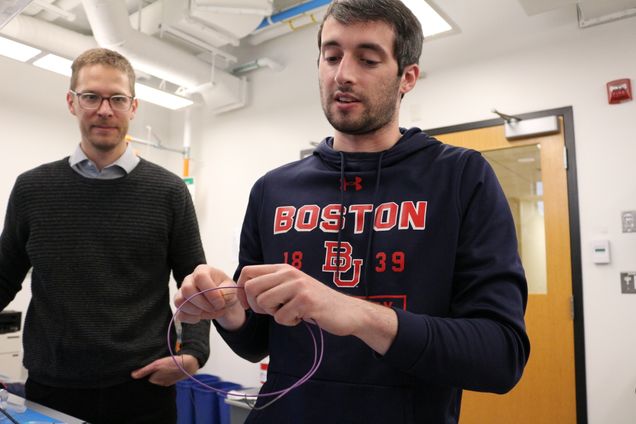BU team’s device clears the way for safer, more effective alternatives to heart-stopping surgery
By Patrick L. Kennedy
It’s the world’s leading killer. Every year, according to the WHO, nearly 18 million people die of cardiovascular disease. That includes arrhythmias, valve disorders, coronary artery disease, and heart failure.
Most of these conditions require often-risky open-heart surgery, which involves temporarily stopping the heart. As an alternative, minimally invasive procedures hold some promise, but several key challenges make them much more difficult for surgeons, and less effective as well.
“We’re trying to mitigate these challenges using soft robotics,” says Jacob Rogatinsky, a doctoral student in Assistant Professor Tommaso Ranzani’s (ME, BME, MSE) lab.
Ranzani and Rogatinsky have developed a millimeter-scale, multifunctional soft robot that overcomes three hurdles that have been hampering minimally invasive heart surgeries. They recently published their results in Science Advances (which featured the device on the journal’s cover), along with colleagues from BU’s Chobanian & Avedisian School of Medicine and Boston Children’s Hospital. Rogatinsky is lead author.
In a minimally invasive procedure, a surgeon makes an incision at some distance from the heart—for example, in the femoral vein of a thigh—and threads a long catheter, just a few millimeters wide, through a blood vessel to the heart. “Think of it like a floppy pool noodle that you’re poking through the blood vessel and twisting around. It’s pretty clunky,” Rogatinsky said.
That tiny size doesn’t allow for a very robust tool once it’s inside the relatively more expansive heart, where there’s more room to work. Moreover, in a minimally invasive procedure, the heart is still beating. “The walls are moving, you’ve got blood pumping constantly,” says Rogatinsky. “It’s difficult to maintain stability inside the heart.”
Finally, the surgeon is trying to maneuver the tip of the catheter—for example, to repair a valve or deliver a stent—from the other end, somewhat like trying to write legibly while holding a pencil by the eraser. “There’s a loss in force transmission the longer your device is,” said Rogatinsky. “You can’t apply the same dexterity as you could by holding a device [close to the tip].”

Over the course of three years, with repeated rounds of feedback from clinicians and cardiovascular surgeons at Children’s Hospital and the Chobanian & Aredisian School, the engineers in Ranzani’s lab developed a better system. They have outfitted a catheter with two critical improvements: a soft-robotic manipulator that can guide surgical instruments to target sites safely and with precision; and a stabilization mechanism that anchors the instrument at the point of entry to the heart. Together, these innovations allow the surgeon to remotely operate with the force and dexterity required while the heart pumps away as usual.
It can squeeze into a very tiny package and then deploy inside the heart, so you have the benefit of a larger robot that has more force and high reachability, but without compromising that access through a very small entry port.”
Tommaso Ranzani
The entire system is collapsible and expandable. From the surgeon’s end, the new device operates much like the existing instrument.
The team successfully demonstrated the device in two distinct types of heart surgery—pacemaker lead placement and tricuspid valve repair—in in vitro and ex vivo tests, and they’re moving on to several rounds of tests in live animal models.
The work combined materials, manufacturing, robotics, electronics and biomedical engineering. “Soft robotics is inherently a very multidisciplinary emerging field,” says Ranzani. “There are so many aspects we have to look at the same time to make this work.”
Eventually, Ranzani and Rogatinsky hope their device will make robotic-assisted surgery available to hospitals that lack such equipment today. “This is a very inexpensive system,” says Ranzani. “We’re very interested in exploring it as a low-cost but still effective alternative for rural areas and countries that don’t have access to all the great facilities we have here in Boston.”
